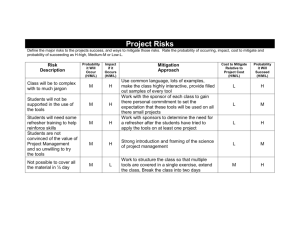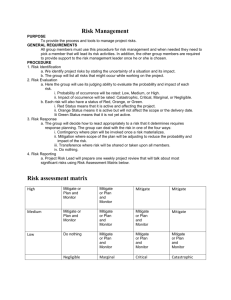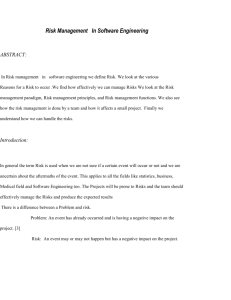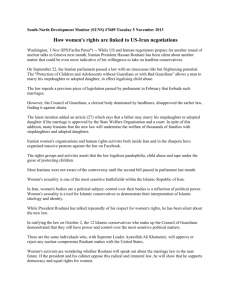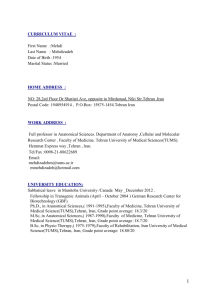How to reduce or mitigate human resource resistance against
advertisement
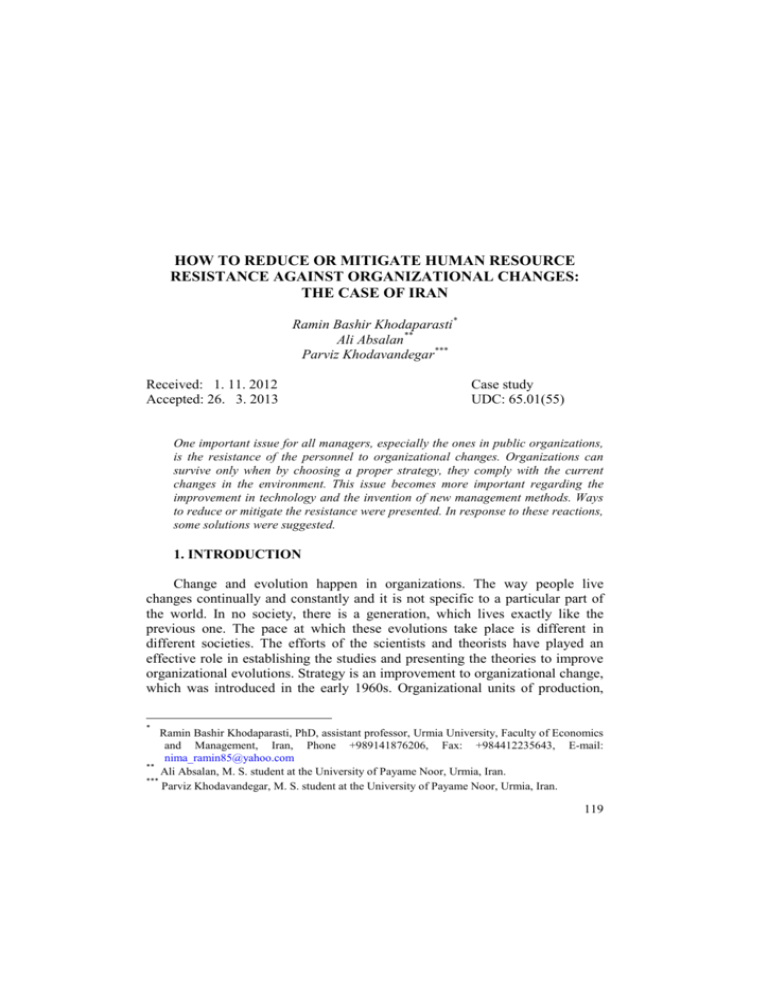
HOW TO REDUCE OR MITIGATE HUMAN RESOURCE RESISTANCE AGAINST ORGANIZATIONAL CHANGES: THE CASE OF IRAN Ramin Bashir Khodaparasti* Ali Absalan** Parviz Khodavandegar*** Received: 1. 11. 2012 Accepted: 26. 3. 2013 Case study UDC: 65.01(55) One important issue for all managers, especially the ones in public organizations, is the resistance of the personnel to organizational changes. Organizations can survive only when by choosing a proper strategy, they comply with the current changes in the environment. This issue becomes more important regarding the improvement in technology and the invention of new management methods. Ways to reduce or mitigate the resistance were presented. In response to these reactions, some solutions were suggested. 1. INTRODUCTION Change and evolution happen in organizations. The way people live changes continually and constantly and it is not specific to a particular part of the world. In no society, there is a generation, which lives exactly like the previous one. The pace at which these evolutions take place is different in different societies. The efforts of the scientists and theorists have played an effective role in establishing the studies and presenting the theories to improve organizational evolutions. Strategy is an improvement to organizational change, which was introduced in the early 1960s. Organizational units of production, * Ramin Bashir Khodaparasti, PhD, assistant professor, Urmia University, Faculty of Economics and Management, Iran, Phone +989141876206, Fax: +984412235643, E-mail: nima_ramin85@yahoo.com ** Ali Absalan, M. S. student at the University of Payame Noor, Urmia, Iran. *** Parviz Khodavandegar, M. S. student at the University of Payame Noor, Urmia, Iran. 119 Management, Vol. 18, 2013, 1, pp. 119-129 R. B. Khodaparasti, A. Absalan, P. Khodavandegar: How to reduce or mitigate human resource… service, education and even every single person are different from another one. Although in some situations the gap resulting from these differences is great, the continuous and constant change always exists as an undeniable fact. Consequently, if a unit does not get along with other members of the society, then it will be subject to failure and dissolution. Sometimes, changes might happen due to deficiencies, shortcomings, defects or differences inside the organization which attracts the attention of superiors in different ways. It is also possible that the results of a research on a particular problem reveal additional facts that make the superiors aware of the necessity of organizational changes. There is no doubt that the management and the human resource departments, without discussing into detail their role in the organization and their significance, are the most important factors in running the organization and the efficiency of any change and evolution depends on the performance of these two departments. However, this perception is not completely true, if we allow it to make us think that such changes and evolutions in different fields have been made easily and will continue forever. If the area is not suitable for change and the change cannot be justified by its benefits to individuals, then people might not welcome those changes. In fact, they will resist them intrinsically and show tenacity. As the human resources and management departments are very important and play a significant role in the organization, making changes and influencing evolution in the workforce are also necessary and must be done delicately. Managing change is important, because the pace at which changes occur has been increasing. Studies show that, in some cases, changes often fail in the beginning. One organizational response to change is the evolution of organizational practices. Thus, the response must apply to the change management. For example, challenges are increasingly competitive and the need to respond to the changing environment causes the creation of new organizational models. The traditional organizational models that follow the operating procedures and the matrix can be complemented with the new models which are based on project teams, networks and virtual structures. Theoretically, most of these new models, such as virtual project-oriented structures, provide more flexibility when responding to changes. However, these models do not always behave in the same way, i.e. the ability to share knowledge and work is different in different organizations. In addition, these models may impact effective communication or employee engagement, which is in turn essential for an effective change. In this sense, managers must be able to create and manage 120 Management, Vol. 18, 2013, 1, pp. 119-129 R. B. Khodaparasti, A. Absalan, P. Khodavandegar: How to reduce or mitigate human resource… change within the organization, so as to ensure that objectives are met and change is produced and at the same time they must ensure that the organization implementing the change process remains committed to the organization itself. Furthermore, the managers must ensure that work and business follow their normal courses. There is a wide range of definitions for the word “change”. Some people believe that the processes which are related to differing, converting, replacing, alternating, displacing and transforming are called a “change”. For most people, change is a kind of shift or switch in a situation from a desirable to an undesirable status. According to Hellriegel, Slocum, and Woodman (1983), the forces of the following areas make the organization change inevitably; they are: societal changes, production potential and services, technological changes and explosion of knowledge. Today, with the explosion of information and the existence of several causes of problems, the organizations are more active and dynamic. Changing the management style of work is difficult, because it requires that many of the things that employees are accustomed to and have become their habit are removed. Therefore, resistance to such change and evolution by staff is something normal and natural. Different reactions can be seen when making a change in an organization. Resistance against changes inside an organization is a prominent one. Therefore, in order to understand the concept of employee resistance it is important to identify what the word resistance refers to. Resistance against change could be defined as the reaction of a person or a group that stops trying to make a change or disrupts it. Alvin Zander (1950), who was one of the first researchers in the field defined resistance to change as a behavior aimed at protecting people against real or imagined change effects. 2. CAUSES OF THE RESISTANCE TOWARD CHANGE According to Kotter and Schlesinger (1979), major causes of resistance to change are: • being aware of the shortcomings of the proposed, i.e. resistant staff might be aware of the potential problems that are likely to be ignored by the agents of change; • uncertainty, i.e. the staff might be unaware of the result and the impact of change on their work; • no interest in surrendering to the benefits, i.e. the employees may suppose that the cost of change is bigger than then the benefit it will achieve. 121 Management, Vol. 18, 2013, 1, pp. 119-129 R. B. Khodaparasti, A. Absalan, P. Khodavandegar: How to reduce or mitigate human resource… According to Kanter (1985), the staff will resist change if they are distrustful and if they lose control of their work. Gersick (1991) believes that apart from potential risks caused by change it is the fear of uncertainty that causes the employees not to want to change. Chaffey (2004) analyzed the views of managers on organizational changes. He divided the managers into four main groups: Information Technology Manager, Human Resources Manager, Marketing Manager and Storing Manager. In his opinion, a Storing manager will not show any reaction against changes, because he/she thinks that the changes will not be made in his area. The points that the Human Resources Manager worries about are new employments and staff education. According to the Information Technology Manager, there are worries about how the staff will develop new skills so as to keep them in the organization and also how to allocate the budget for the expenses efficiently. This manager also believes that when information technology enters his organizational area, this area’s power and budget will increase, because when changes occur the opportunity of creating new communication channels in the market open up causing an increase in the exchanges of goods as well. This research shows that there are some reasons that can prevent staff resistance to changes. In other words, the results of the questionnaire show that the staff is not always sure about the commitment of the organization to the assumed obligations. Although most of the staff might be satisfied with their job, they are still concerned about their career and believe that a precise and careful planning does not take place before implementing the changes in the organization. As in such organizations the relationship between the managers and the staff is not very close, the reasons why changes are needed are not explained to the staff. It means that the managers do not feel it is necessary to inform the staff about the reasons for making the changes because most of the changes take place at senior levels. 3. WAYS TO REDUCE AND MITIGATE RESISTANCE TO CHANGES Managers of the organization are responsible for discovering the real reasons for staff’s resistance to change. They should also be flexible enough to overcome the resistance of the subordinates. Kotter and Schesinger (1979) suggest in their research six ways of overcoming resistance of the personnel which are: open and hidden persuasion, facilitation and support, training and communication, influencing the director and getting close to him/her, negotiation and resistance, and finally participation and quarrel. In his book, 122 Management, Vol. 18, 2013, 1, pp. 119-129 R. B. Khodaparasti, A. Absalan, P. Khodavandegar: How to reduce or mitigate human resource… Roy McLennan (1989) deals with ways of reducing factors of resistance. These factors are: • supporting top-level managers at the beginning of executive programs, • making the staff believe in the usefulness of the change and reducing their burden of responsibilities after the change, • creating a sense of involvement in the project, • not closing the project for a review if needed, • offering a possibility of providing description for a correct interpretation of the project, • encouraging participation of individuals, • minimizing the risk of endangering participants’ security, • facilitating the possibility that the staff accept each other and; • motivating the participants to experience change. In another study, Jeff Hiatt (2006) presents a model to manage a change, which is known as the ADKAR model. This model is created by combining the concepts of Awareness, Desire, Knowledge, Ability, and Reinforcement. It is studied in two dimensions. The horizontal axis shows the characteristics of human resources and the vertical axis shows the stages of the project of change. After conducting this research, we found out that a successful change occurred when these two dimensions were considered at the same time. Washington and Marla (2005) see the changing factor as an important factor in the quality of change execution. When the changer is more aware, he will have a positive view of organizational change, his resistance will increase and he will be able to bring the staff along. In a study, conducted in Iranian organizations, by Razavi, Hashemian, Kazemi, Tavazoee, and Mashayekhi (2010), the following factors affecting correct organizational change are identified. They believe that: • Managers should pay enough attention to quality and effectiveness of the new procedures; • Encouragement and punishment policies should be considered by the managers, and the staff should be informed about the effect and effectiveness of the new procedures; • Managers of the organization should execute new standards, as long as these can be applied. Having analyzed the aforementioned reasons and the administrative structure of Iranian organizations, some solutions are presented to help reduce staff resistance to strategies leading to organizational change. Those might include: generating enough motivation to change the mentality of the staff, strengthening (positive feedback), abandoning the behavior that caused the 123 Management, Vol. 18, 2013, 1, pp. 119-129 R. B. Khodaparasti, A. Absalan, P. Khodavandegar: How to reduce or mitigate human resource… problem, and identifying and developing new behaviors, reforming and using successful methods of communication of managers with individuals in the organization, careful planning which is clear for all stages of the project change, using appropriately self-ability, creating an inner vision of the people by involving them in the process, encouraging creative thinking, using new technologies, empowering employees and developing leadership skills. 4. VARIOUS APPROACHES TO REDUCE RESISTANCE TO CHANGE Life of an organization depends on the skills and the general or technical awareness of its human resources. These factors play an important role in increasing the compatibility of the organization with the conditions of the environmental variable. Therefore, both education and development of human resources play a big role in developing staff's knowledge and professional skills. Cascio (1995) believes that education and staff improvement consist of specially designed programs that improve the function on individual, group or organizational levels. Furthermore, education makes individuals more involved in improving the organization’s effectiveness and more easily adaptable to the pressures of the environmental variable. Technological changes, and technology as an agent of change in organizations, can make a complete change in organizational skills and knowledge. Therefore, continuous education is extremely important and necessary. One of the important approaches in managing and improving human resources is organizational development. According to this method, an appropriate decision making process is created and organizational performance is improved in the process. Black and Margulies (1989) think that organization improvement is a planned change that has a systematic view and is planned in both the short and the long term with the aim of improving the organization. They believe that the changes are designed to solve organizational problems and focus on human-society relations. Change is considered to be one of the processes within the organization and not a separate part of it. Waddell and Sohal (1998) view change in a different way. Unlike other researchers, they believe that resistance has many advantages and is problematic only if managers consider it to be problematic and do not pay attention to its advantages. They believe that a lack of theories to manage a change and models for that make it impossible to achieve these benefits. In a research, Kreitner and Konicki (2001) consider the close relationship between effective change and people’s resistance. They come to the conclusion that to make a change in the 124 Management, Vol. 18, 2013, 1, pp. 119-129 R. B. Khodaparasti, A. Absalan, P. Khodavandegar: How to reduce or mitigate human resource… behavior of the staff, the best way is to overcome employees’ resistance to change and make them willing to adopt new behaviors. In another research, Adner and Helfat (2003) show that, managers' decisions are greatly influenced by their particular insights. This feature causes organizational change to be influenced by their tendencies. A research conducted by Jennifer and Kerry (2007) shows that successful implementation of organizational change depends on the acceptance of these changes by the employees. Developed countries have made a good progress in educating and training staff. This cannot be said for developing countries like Iran. Therefore, the staff of Iranian organizations shows more resistance to changes, which is a challenge to Iranian managers and executives. However, few studies have been done on issues of organization change. Amiri, Rasaeefard and Dastan (2011) reach the conclusion that the Iranian government agencies offer no programs to encourage employee creativity and change. Meanwhile, the employees tend to show their creativity and are aware of both the need to change and of the lack of the required knowledge and skills. The staff thinks that the decisions of the managers do not enable the organization to achieve success. They also believe that the biggest problem of these organizations is their failure to communicate and cooperate on the team work basis. The research group made some suggestions to solve this problem, including: participation of employees in decision making, making a comprehensive communication system in the organization, raising awareness of changes in various ways, developing the required skills through training, reducing bureaucracy, developing and encouraging creativity and variability, promoting specialization, improving the leadership quality of the managers, paying attention to team work, developing a strategic outlook on the basis of strategic organizational management, coordinating between the individual employee and organizational goals, and finally supporting the local culture compatible with changes and organizational innovation. 5. MODIFYING AND REVISING THE ORGANIZATIONAL CULTURE Organizational culture is a new issue in management knowledge and in the process of organizational behavior. Culture has been long used to describe the quality of life in a human society. Organization is a metaphor for order and culture in an organization; it is like a personality of a human being. In fact, analyzing the definitions of most studies, it can be said that organizational culture is a combination of values, beliefs, opinions, theories and norms governing organizations. In other words, organizational culture is a concept that 125 Management, Vol. 18, 2013, 1, pp. 119-129 R. B. Khodaparasti, A. Absalan, P. Khodavandegar: How to reduce or mitigate human resource… will be taught to new members into the organization and expresses a pattern of the common objectives of the organization. An important factor in revising organizational culture is studying the issues related to human resources management, which has been long considered in developed countries. So far, these countries have devoted much effort to achieve the goals of continuously improving their administrative system and creating an ideal organizational culture. The characteristics of such organizations are as follows: • In these countries, no special attention is paid to proper methods of evaluating talent, ability and motivation to work, when recruiting new employees; • Proper education and training is designed for staff promotion; • Employees are jointly responsible towards their duties; • Employee assessment and promotion are done slowly and gradually; • The staff is educated in a way that they pay attention to their improvement as well as to the improvement of others and to the efforts of cooperation; • The staff tries to upgrade the organization to a higher level and wants to make a better future for it. Keup, Walker, Austin and Lindholm (2001) believe that the effective factors in the process of organizational change are: making it ready for an organizational change and responding to it, reducing resistance against the plan of change and improving the results of the process. In other words organizational culture is the effective factor in the process of organizational change. The results of studies conducted by Pang and Lam, (2003) and Smith (2003) show the influence of organizational culture on accepting or resisting organizational change. Rashid, Sambasivan, Rahman, (2004) believe that attitudes toward organizational change are influenced by organizational culture. Maurer (2006) says culture is the background of a successful change. Therefore, the necessity to promote change is a preparation of both the individuals and the organization. He considers that some factors have an effect on organizational failure. In his view, these main factors are: a low level of organization quality, low attention given to preparing employees through training and, ultimately, resistance to change. According to Paton, Beranek et al (2008) and Smith (2008), the functions of management change include participation of the individuals in the change process, setting priorities, fulfilling tasks, mapping the motion of the current 126 Management, Vol. 18, 2013, 1, pp. 119-129 R. B. Khodaparasti, A. Absalan, P. Khodavandegar: How to reduce or mitigate human resource… situation to the desired situation in the future. They believe that change management studies the current situation of the organization, its future situation and ways of guiding through current situation to the desired situation. In Iran, as a developing country, some efforts have been made recently to improve organizational culture. Organizations in different developed countries have been studied to model their strengths. Iran is an Islamic country that has tried to imitate that interaction following Islamic patterns. Certain characteristics of Islamic ethics must be included in organizations and must pertain to, employees. Islamic moral features that are expected from an employee in organizations in Iran are: piety, knowing how to work, patience in dealing with clients, loving people, humility, good-temperedness, public service, being friendly, respecting the client, justice and fairness, obedience to superiors, brotherhood and intimacy with colleagues and finally the consultative spirit. 7. CONCLUSION Resistance can be defined as a reaction of an individual or a group who attempts to stop an effort to make a change or disrupts it. The Iranian employees are unsure whether the organization is committed to the considered obligations. They are worried about their career in the future and believe that a precise and exact planning does not take place before implementing the changes in the organization. As in such, relationships between the managers and the staff are not close, since reasons for changes are not explained to staff by the managers. Managers do not feel the necessity to inform the staff about the reasons for the changes because most of the changes take place in senior levels. In order to prevent the aforementioned problems and to reduce the resistance against organizational changes, the staff ought to be prepared for changes that first need to be justified. Accordingly, some solutions can be suggested: to create enough motivation for people to change their minds, to strengthen behaviors positive feedback, to quit problematic behaviors and to identify and develop new behaviors. Other important issues include: correcting mistakes and using successful methods of communication with, careful and clear planning for all phases of the change project, optimum use of their own abilities and that of other people around them (i.e. consulting), creating an inner insight in people by getting them involved and paying more attention to their mental experience, accepting creative thinking, using new technologies, increasing their empowerment and developing leadership skills of others are also important. 127 Management, Vol. 18, 2013, 1, pp. 119-129 R. B. Khodaparasti, A. Absalan, P. Khodavandegar: How to reduce or mitigate human resource… REFERENCES 1. Zabid, A. R.; Sambasivan, M.; Abdul Rahman, A. (2004). The influence of organizational culture on attitudes toward organizational change, Leadership & Organization Development Journal, 25 (2), pp.161 – 179. 2. Adner, R.; Helfat, C. E. (2003). Corporate effects and dynamic managerial capabilities, Strategic Management Journal, 24 (10), pp. 1011- 1025. 3. Ali Naghi, A.; Rasaeefard, R. et al. (2011). An Analysis of Changeability Ground in Iranian Public Organizations: A Case Study in the Cities of Lamerd and Mohr, Iranian Journal of Management Studies, 4 (2), September, pp.121-142. 4. Black S.; Margulies, N. (1989). An Ideological Perspective on Participation: A case for Integration, Journal of Organizational Change Management, 2 (1), pp. 13-34. 5. Cascio, W, F. (1995). Managing Human Resources, New York: McGrawHill Inc. 6. Chaffey, D. (2004). E - Business and E-Commerce management: Strategy, Implementation and Practice. 2nd Ed. Harlow, England: Prentice Hall. 7. Dianne, W; Sohal, A. S. (1998). Resistance: a constructive tool for change management, Management Decision, 36 (8), pp. 543 –548. 8. Gersick, C. J. G. (1991). Revolutionary change theories: A multilevel exploration of the punctuated equilibrium paradigm. Academy of Management Review, 16, pp. 10-36. 9. Hellriegel, D. J.; Slocum, W. et al (1983). Organizational Behavior, 5th Ed. St. Paul, MN: West. 10. Jennifer F.; Kerry, B. (2007). First steps: Linking change communication to change receptivity. Journal of Organizational Change Management, 20 (3), pp. 370- 387. 11. Hiatt, J. (2006). A model for change in business, government and our community, change management center, Published by Prosci Research. 12. Kanter, R. M. (1985). Managing the human side of change. Management Review, 74, pp. 52-56. 13. Keup, J. R.; Walker, A. A.; Astin, H. S.; Lindholm, J. A. (2001). Organizational culture and institutional transformation: Washington, DC: ERIC Clearinghouse on Higher Education, ED464521. 14. Kotter, J. P.; Schlesinger, L. (1979). Choosing Strategies for Change. Harvard Business Review, 57 (2), pp. 106- 114. 15. Kreitner, R.; Kinicki, A. (2001). Organizational Behavior 5th Ed. New York: Mc Graw – Hill. 128 Management, Vol. 18, 2013, 1, pp. 119-129 R. B. Khodaparasti, A. Absalan, P. Khodavandegar: How to reduce or mitigate human resource… 16. Smith, M. E. (2003). Changing an organization's culture: correlates of success and failure, Leadership & Organization Development Journal, 24 (5), pp. 249 – 261. 17. Maurer, R. (2006). Building a foundation for change, Journal for Quality Participation, 24 (3), pp. 9-38. 18. Pang, N. S. K.; Lam, J. Y. L. (2003). The relative effects of environmental, internal and contextual factors on organizational learning: the case of Hong Kong schools under reforms, Learning Organization, 10 (2), pp. 83 – 97. 19. Paton, B.; Beranek, L. et al (2008). The transit lounge: a view of organizational change from a point in the journey. Library Management, 29 (1/2), pp. 87-103. 20. McLennan, R. (1989). Managing Organizational Behaviour. Prentice-Hall. 21. Vahid, S.; Razavi, M. H. et al (2010). Investigation on Dynamics of Structure Change in Organizations: The Cultural Aspect, Proceedings of the 28th International Conference of the System Dynamics Society, July 25 – 29, Seoul, Korea. 22. Washington, M; Marla, H. (2005). Why change fails: Knowledge counts. Leadership & Organization Development Journal, 26 (5), pp. 400 – 411. 23. Zander, A. (1950). Resistance to Change - Its Analysis and Prevention, Advanced Management Journal, 15 (1), pp. 9-11. KAKO SMANJITI OTPOR PREMA ORGANIZACIJSKIM PROMJENAMA: SLUČAJ IRANA Sažetak Značajno pitanje za sve menadžere, a posebno one u javnom sektoru, odnosi se na otpor zaposlenika prema organizacijskim promjenama. Organizacije mogu preživjeti samo kada biraju odgovarajuću strategiju, koja je usklađena s promjenama u okruženju. Ovo pitanje postaje sve značajnije, s obzirom na napredak tehnologije i uvođenjem novih menadžerskih metoda. Nadalje se prezentiraju načini za smanjivanje otpora organizacijskim promjenama. Kao odgovor na navedene reakcije, preporučuju se odgovarajuća rješenja. 129
